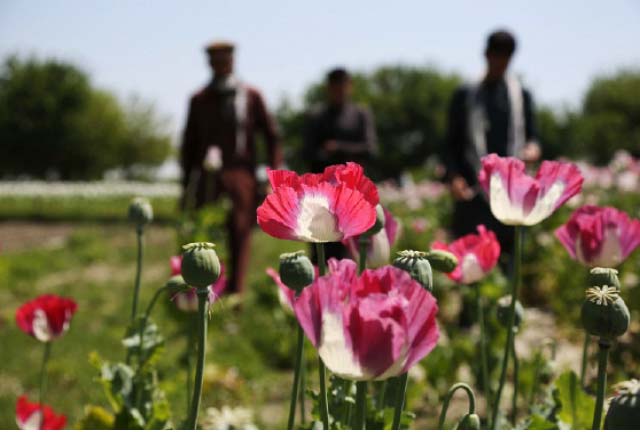Since 2001, the production of opium in the country has increased by 40 times fueling organized war, crime and widespread bloodshed throughout the country. Afghanistan’s opium poppy production goes into more than 90% heroin worldwide. Afghanistan has been the world's greatest illicit opium producer, ahead of Burma, and Latin America since 1992. This amounts to an export value of about $110 billions while less than a quarter being earned by opium farmers and the rest going to district officials, insurgents, warlords, and drug traffickers. In addition to opiates, Afghanistan is also the largest producer of cannabis (mostly as hashish) in the world. However, several fatwas (religious degree) issued by Muslim clergymen claiming that opium production is contrary to the sharia law and that opium producers would face punishments in accordance with the sharia.
According to the latest expression of some parliament members Afghanistan, foreigners are gaining billions of dollars from the drug trade in Afghanistan every year. “They all are engaged in drug smuggling during nights and get $110 billion a year while they give us only a few billion in charity.” Main smugglers are the foreigners; I have documents about [drug] smuggling in Helmand [province]," said MP Obaidullah Barekzai. In the meantime, the Interior Minister, Taj Mohammad Jahid, who was called to the house, talked about the problems before government's counter-narcotics mission."There is a lack of budget; the money allocated by government in this respect is quite different from the money allocated by mafia to promote this trend," Minister of Public Health Ferozuddin Feroz said."The capacity of our organization is not equivalent to the current challenges. According to statistics, more than three million people are in some way engaged in the drug trade, while we have only 2,500 personnel," added Ahmadi. "Security threats have had a direct role on the increasing level of poppy cultivation [in Afghanistan]," Counter-Narcotics Minister Salamat Azimi said.
These statements come a day after the United Nations Office on Drug and Crime (UNODC) announced that based on a new survey of UNODC this year, the total land area that has been cultivated with poppies has increased by 10 percent compared to the last year. Andrey Avetisyan, the UNODC regional representative said on Sunday that based on their new survey, drug production in Afghanistan will surge by 43 percent. The UN representative said maintaining security, overcoming the endemic corruption and economic growth in the country is related to the eradication of poppy fields. "Drugs have direct links with corruption, terrorism and development. Without tackling drug problem and elicit economy, in general, it will not be possible to solve other problems facing Afghanistan," Avetisyan said.
It is also said that there is an important link between drugs and hawala (informal money transfer system) in Afghanistan. According to some previous analysis had been based on interviews with 54 hawala dealers in the main centers of hawala activity of Afghanistan as well as during a visit to neighboring countries. Likewise, interviews had been conducted with users of the hawala system (drug dealers, businessmen, traders, international aid workers), regulators (government officials, central bank personnel), and formal service providers (bankers, accountants). In addition to hawala, they found protection payments and connections, by which the drug industry had major linkages with local administration as well as high levels of the national government.
Different localities by the UNODC give dissimilar views of the laundering of drug funds. It is difficult to get a solid sense of the overall economy. In Faizabad, for example, indicated that during certain times of the year close to 100% of the liquidity of the hawala system in the province is derived from drugs, whereas in Herat, it was estimated that only 30% of the hawala market's overall transaction volume is directly linked to drugs. Analysis of data gathered in places like Herat was complicated by confirmed links between drug money and legitimate imports. The southern region (Helmand and Kandahar provinces) is also a key centre for money laundering in Afghanistan (about 60% of the funds are drug related and 80–90% of the hawala dealers in Kandahar [the former Taliban stronghold] and Helmand are involved in money transfers related to narcotics).
Helmand has emerged as a key facilitator of the opium trade, both between provinces and exports, while overall estimates of the local hawala markets' drug-related component are of a similar order of magnitude to those in Kandahar. This finding adds weight to the notion that the major trading centers in these two neighboring provinces should be treated as essentially one market. It is said that Helmand could account the largest drug-related hawala business while Herat is the second largest contributor in the country.
Furthermore, regional countries appears to be a central clearing house for international hawala activities and major transaction centers. It appears that even in the case of drug shipments, payments for them come into Afghanistan. The hawala system has been key to the deepening and widening of the "informal economy" in Afghanistan, where there is anonymity and the opportunity to launder money. Hawala, however, also contributes positively to the regional economy. It has been central to the survival of Afghanistan's financial system through war. It also plays an important role in currency exchange. Finally, frequent studies and field facts within past 15 years confirm that there have not been any political will against opium traffic and cultivation in Afghanistan.
Home » Opinion » Opium Fueling War and Crime in Afghanistan
Opium Fueling War and Crime in Afghanistan
| Mohammad Zahir Akbari

